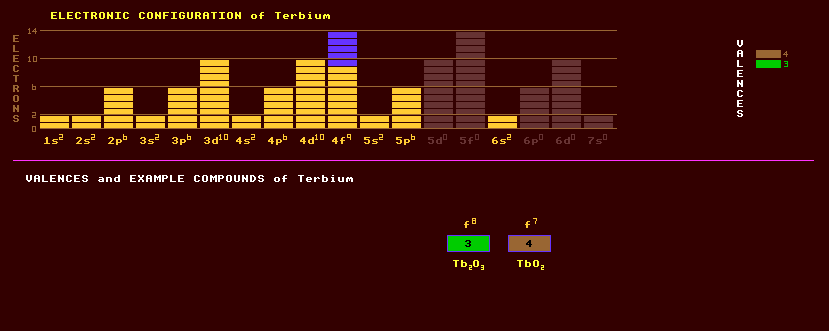

|
65 TERBIUM Tb (Ytterby, a town in Sweden)
A silvery white malleable, ductile rare earth metallic element of the lanthanide series soft enough to be cut with a knife. Terbium, like all rare earths, has been isolated only recently with the development of ion-exchange techniques for separating the rare earth elements. As with other rare earths, it can be produced by reducing the anhydrous chloride or fluoride with calcium metal in a tantalum crucible. Calcium and tantalum impurities can be then removed by vacuum re-melting. Other methods of isolation are possible. Terbium is reasonable stable in air. Two crystal modifications exist, with a transformation temperature of 1315 Celsius. Terbium is used to dope calcium fluoride, calcium tungstate, and strontium molybdate, used in solid state devices. Paramagnetic at normal temperatures, terbium becomes superconducting below 237 Kelvin. Like all lanthanide rare earths, terbium is predominantly trivalent, but also forms tetravalent compounds. The oxide is a chocolate brown or dark maroon colour with potential application as an activator for green phosphors used in colour TV tubes. It can be used with ZrO2 as a crystal stabiliser of fuel cells which operate at elevated temperatures. Sodium terbium borate is used as a lasing material which emits coherent light of 5460 Angstroms. Terbium Ferrite Cobalt is now the preferred magnetic film material for magneto-optical re-recordable CDs and computer discs rather than other rare-earth alloys because it requires one third the power to magnetise it. An alloy of terbium, dysprosium and iron which changes in dimension when within a magnetic field is used as a smart material. It is found in cerite, gadolinite, and other minerals along with other rare earths. It is recovered commercially from monazite in which it is present to the extent of 0.03%, from xenotime, and from euxenite, a complex oxide containing 1% or more of terbia. Terbium exists as just one stable isotope, terbium-159. Twenty five radioactive isotopes are known, ranging from the inverse beta decaying terbium-148 to the beta decaying terbium-165. Claim to fame:
|
![]()